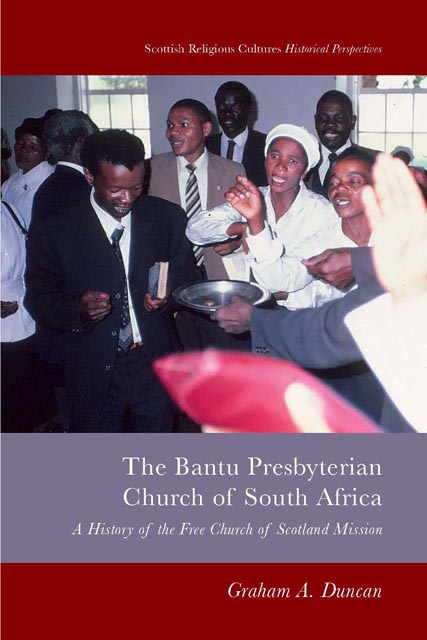Book contents
- Frontmatter
- Contents
- Acknowledgements
- Timeline
- A Presbyterian Anthem
- Introduction
- 1 Background to this Study
- 2 The Origins and Early Development of Scottish Presbyterian Mission in South Africa, 1824–65
- 3 Rev. Tiyo Soga (1829–71): A Paragon of Early Indigenous Leadership
- 4 The Role of Mission Councils in the Scottish Mission in South Africa, 1864–1923
- 5 The Rev. Edward Tsewu’s Dispute with the Free Church of Scotland Mission
- 6 The Mzimba Secession, 1898: A South African ‘Disruption’
- 7 Presbyterianism in South Africa, 1897–1923: To Unite orNot to Unite?
- 8 Preparations for the Formation of the Bantu Presbyterian Church of South Africa, 1897–1919
- 9 The Formation of the Bantu Presbyterian Church of South Africa, 1920–3
- 10 Mission to Church – Church to Mission: The First Ten Years, 1923–33
- 11 Reaching Out: The Bantu Presbyterian Church in South Africa and the Presbyterian Church of South Africa and Ecumenism, 1923–39
- 12 The Bantu Presbyterian Church in South Africa and Ecumenism, 1940–99
- 13 The End of Mission Councils: The Church of Scotland South Africa Joint Council, 1971–81
- 14 A Young Church in Mission or Maintenance Mode?: The Bantu Presbyterian Church of South Africa, 1923–99
- 15 The Bantu/Reformed Presbyterian Church and Socio-political Issues
- 16 Bantu/Reformed Presbyterian ChurchWomen in Leadership in Ministry
- Conclusion: Indigenous Presbyterians and Missionaries –Transferring Contending Roles and Responsibilities
- Bibliography
- Index
1 - Background to this Study
Published online by Cambridge University Press: 26 November 2022
- Frontmatter
- Contents
- Acknowledgements
- Timeline
- A Presbyterian Anthem
- Introduction
- 1 Background to this Study
- 2 The Origins and Early Development of Scottish Presbyterian Mission in South Africa, 1824–65
- 3 Rev. Tiyo Soga (1829–71): A Paragon of Early Indigenous Leadership
- 4 The Role of Mission Councils in the Scottish Mission in South Africa, 1864–1923
- 5 The Rev. Edward Tsewu’s Dispute with the Free Church of Scotland Mission
- 6 The Mzimba Secession, 1898: A South African ‘Disruption’
- 7 Presbyterianism in South Africa, 1897–1923: To Unite orNot to Unite?
- 8 Preparations for the Formation of the Bantu Presbyterian Church of South Africa, 1897–1919
- 9 The Formation of the Bantu Presbyterian Church of South Africa, 1920–3
- 10 Mission to Church – Church to Mission: The First Ten Years, 1923–33
- 11 Reaching Out: The Bantu Presbyterian Church in South Africa and the Presbyterian Church of South Africa and Ecumenism, 1923–39
- 12 The Bantu Presbyterian Church in South Africa and Ecumenism, 1940–99
- 13 The End of Mission Councils: The Church of Scotland South Africa Joint Council, 1971–81
- 14 A Young Church in Mission or Maintenance Mode?: The Bantu Presbyterian Church of South Africa, 1923–99
- 15 The Bantu/Reformed Presbyterian Church and Socio-political Issues
- 16 Bantu/Reformed Presbyterian ChurchWomen in Leadership in Ministry
- Conclusion: Indigenous Presbyterians and Missionaries –Transferring Contending Roles and Responsibilities
- Bibliography
- Index
Summary
Mission and Migration
Andrew Walls (2014: 19–37), the doyen of global mission history (Kalu et al. 2005: xi–xii), asserts the essential nature of mission as human participation in the missio Dei. Van Dyk (2011: 20) describes it as ‘an irrepressible human urge’. People are called out from their secure situations to become ‘perennial migrants’ (Walls 2014: 20), agents of God's revelation, concurring with Richard Rohr's (2011: 21) assertion that ‘someone has to make it clear to us that homes are not meant to live in but to be moved out from’. Coleman and Elsner (1995: 206) use the imagery of pilgrimage rather than migration, but with a similar understanding as: ‘the experience of travel and the constant possibility of encountering the new …’, while Műller (2011: 11) considers it a ritual engaged in by people ‘who remain hopeful in the possibility of a future, preferable to the travails of the present’. All of these meanings indicate movement towards an end point – the kingdom of God.
Walls (2014: 21) distinguishes two types of migration; the Adamic and the Abrahamic models; the former indicates a situation of ‘disaster deprivation and loss’ through incurring a penalty as we discover in the biblical story of the Fall; the latter implies ‘escape to a superlatively better future’ through Abraham receiving a promise that through mission God would make him the father of the nations. Both types of migration model were present in the South African context. However, the result may not be so clear cut as the experience of the migrant in relation to the receiving culture is determined by the receiving community's ‘own numbers and social cohesion’. Unfortunately, many migrants have discovered anything but a welcome in the global diaspora. Incoming missionary migrants to South Africa brought with them both their historical identity and memory and their differing theologies, factors which were determinative for the results of their mission.
Historically, Walls describes the ‘Great European Migration’ process in the modern period, which lasted from the beginning of the sixteenth century until the middle of the twentieth century. During its course, first hundreds and then thousands and eventually millions of people left Europe for lands beyond Europe.
- Type
- Chapter
- Information
- Bantu Presbyterian Church of South AfricaA History of the Free Church of Scotland Mission, pp. 4 - 17Publisher: Edinburgh University PressPrint publication year: 2022

